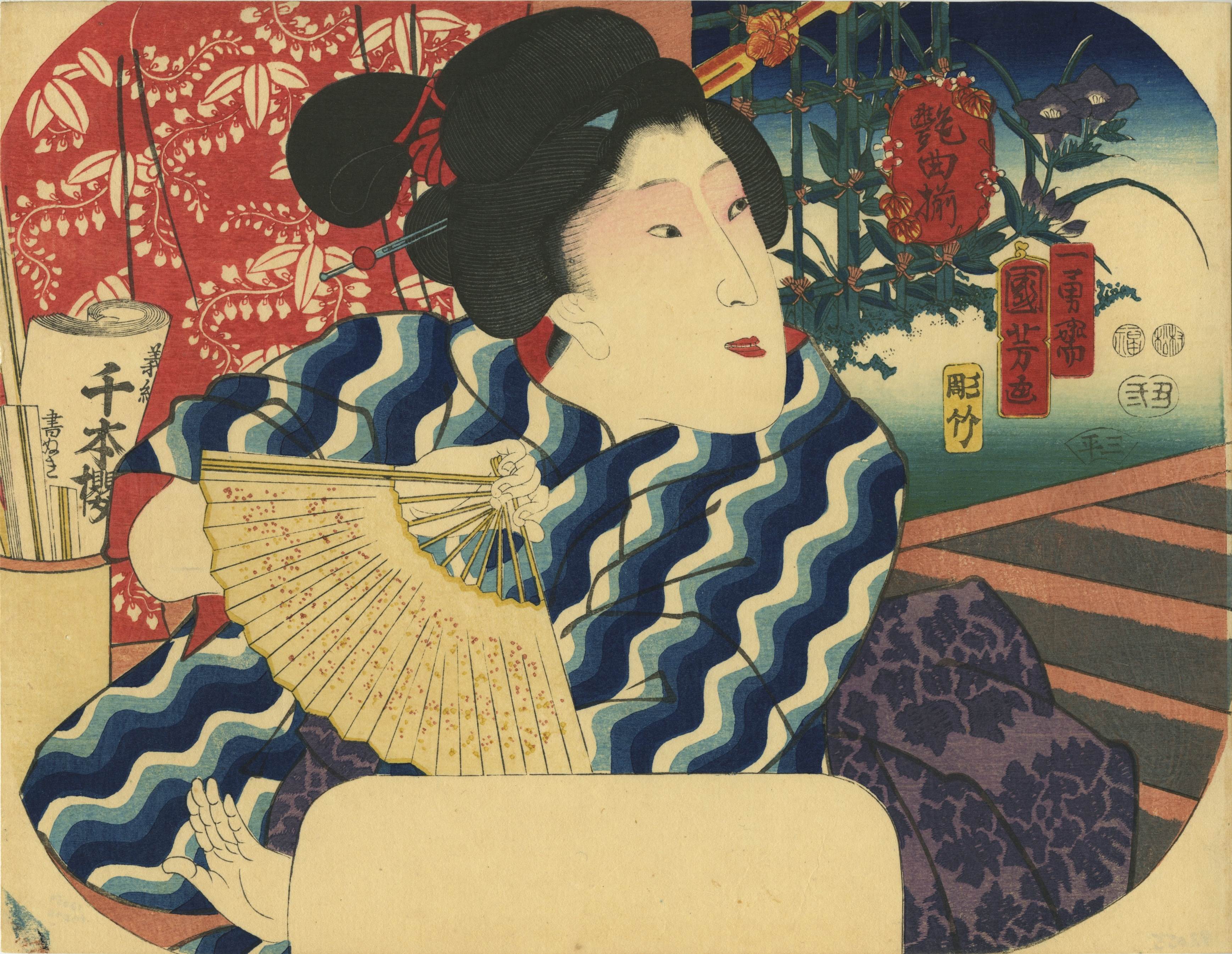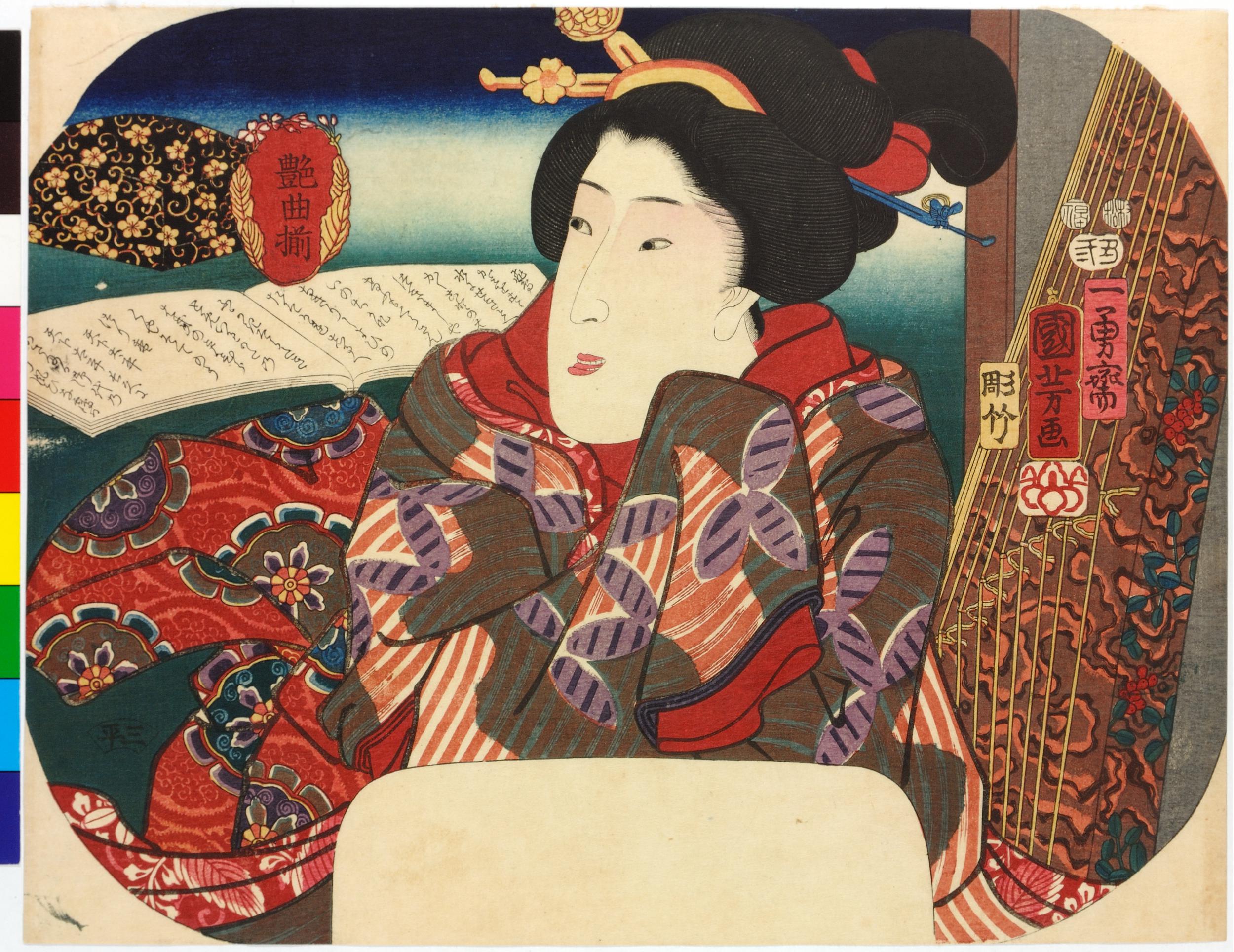-
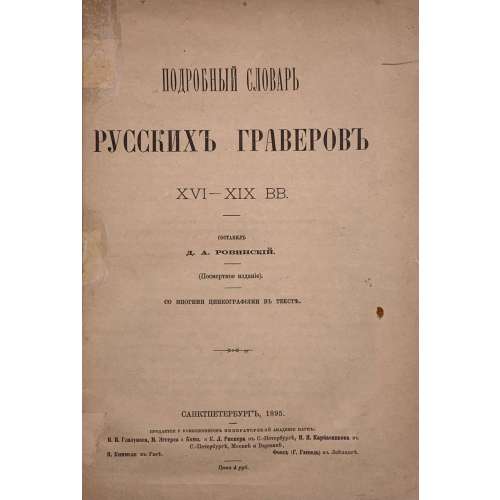 Title: ПОДРОБНЫЙ СЛОВАРЬ | РУССКИХЪ ГРАВЕРОВЪ | XVI-XIX ВВ. | СОСТАВИЛЪ Д. А. РОВИНСКIЙ. | (ПОСМЕРТНОЕ ИЗДАНIЕ). | СО МНОГИМИ ЦИНКОГРАФIЯМИ ВЪ ТЕКСТѢ. | САНКТПЕТЕРБУРГЪ, 1895. | ПРОДАЕТСЯ У КОМИССIОНЕРОВЪ ИМПЕРАТОРСКОЙ АКАДЕМИИ НАУКЪ: | И. И. Глазунова, М. Эггерса и Комп. и К. Л. Риккера въ С.-Петербургѣ, Н. П. Карбасникова въ | С.-Петербургѣ, Москвѣ и Варшавѣ, | Н. Киммеля въ Ригѣ. Фоссъ (Г. Гэссель) въ Лейпцигѣ. | Цена 4 руб. Pagination: [2] t.p./colophon, [2] dedication/blank, [2] f.t. ИСТОРИЧЕСКIЙ ОБЗОРЪ | ГРАВИРОВАНIЯ / blank; 1-344 (numbered half-pages, 86 leaves); [2] f.t. СЛОВАРЬ ГРАВЕРОВЪ. / blank, 1-806 [808 blank] (numbered half-pages, 202 leaves) Collation: 8vo; π3 1-258 262. Книга состоит из двух разделов с раздельной пагинацией. Первая часть "Исторический обзор гравирования", вторая – собственно "Словарь граверов". В обеих частях пронумерованы половины страниц.
Title: ПОДРОБНЫЙ СЛОВАРЬ | РУССКИХЪ ГРАВЕРОВЪ | XVI-XIX ВВ. | СОСТАВИЛЪ Д. А. РОВИНСКIЙ. | (ПОСМЕРТНОЕ ИЗДАНIЕ). | СО МНОГИМИ ЦИНКОГРАФIЯМИ ВЪ ТЕКСТѢ. | САНКТПЕТЕРБУРГЪ, 1895. | ПРОДАЕТСЯ У КОМИССIОНЕРОВЪ ИМПЕРАТОРСКОЙ АКАДЕМИИ НАУКЪ: | И. И. Глазунова, М. Эггерса и Комп. и К. Л. Риккера въ С.-Петербургѣ, Н. П. Карбасникова въ | С.-Петербургѣ, Москвѣ и Варшавѣ, | Н. Киммеля въ Ригѣ. Фоссъ (Г. Гэссель) въ Лейпцигѣ. | Цена 4 руб. Pagination: [2] t.p./colophon, [2] dedication/blank, [2] f.t. ИСТОРИЧЕСКIЙ ОБЗОРЪ | ГРАВИРОВАНIЯ / blank; 1-344 (numbered half-pages, 86 leaves); [2] f.t. СЛОВАРЬ ГРАВЕРОВЪ. / blank, 1-806 [808 blank] (numbered half-pages, 202 leaves) Collation: 8vo; π3 1-258 262. Книга состоит из двух разделов с раздельной пагинацией. Первая часть "Исторический обзор гравирования", вторая – собственно "Словарь граверов". В обеих частях пронумерованы половины страниц. -
![[RASPE, Rudolf Erich]. The Travels and Surprising Adventures of Baron Munchausen. / Illustrated with 37 curious engravings, from the Baron's own designs, and five woodcuts, by G. Cruikshank. — London: William Tegg, 1869. — xii + [10] + 268 pp.](https://varshavskycollection.com/wp-content/uploads/2021/02/LIB-2269.2019-5-scaled-500x500.jpeg) Half-title: BARON MUNCHAUSEN Title: THE TRAVELS | AND | SURPRISING ADVENTURES | OF | BARON MUNCHAUSEN. | ILLUSTRATED WITH | THIRTY-SEVEN CURIOUS ENGRAVINGS, | FROM | THE BARON'S OWN DESIGNS, | AND FIVE WOODCUTS, | BY G. CRUIKSHANK. | [device] | LONDON : WILLIAM TEGG. | 1869.|| [RASPE, Rudolf Erich]. The Travels and Surprising Adventures of Baron Munchausen. / Illustrated with 37 curious engravings, from the Baron's own designs, and five woodcuts, by G. Cruikshank. — London: William Tegg, 1869. Pagination: xii + [10] + 268 pp, 23 plates: hand-coloured engraved frontispiece, 5 woodcuts by Cruikshank, other b/w etchings, two folding plates. Binding: 19 x 13 cm; hardbound, 8vo, early 20th century 3/4 dark plum morocco gilt-ruled, raised bands, title label, gilt lettering, gilt in compartments, top edge gilt. Catalogue raisonné: A. Cohn: #584, p. 172. This edition is an identical re-issue of the 1867 edition.
Half-title: BARON MUNCHAUSEN Title: THE TRAVELS | AND | SURPRISING ADVENTURES | OF | BARON MUNCHAUSEN. | ILLUSTRATED WITH | THIRTY-SEVEN CURIOUS ENGRAVINGS, | FROM | THE BARON'S OWN DESIGNS, | AND FIVE WOODCUTS, | BY G. CRUIKSHANK. | [device] | LONDON : WILLIAM TEGG. | 1869.|| [RASPE, Rudolf Erich]. The Travels and Surprising Adventures of Baron Munchausen. / Illustrated with 37 curious engravings, from the Baron's own designs, and five woodcuts, by G. Cruikshank. — London: William Tegg, 1869. Pagination: xii + [10] + 268 pp, 23 plates: hand-coloured engraved frontispiece, 5 woodcuts by Cruikshank, other b/w etchings, two folding plates. Binding: 19 x 13 cm; hardbound, 8vo, early 20th century 3/4 dark plum morocco gilt-ruled, raised bands, title label, gilt lettering, gilt in compartments, top edge gilt. Catalogue raisonné: A. Cohn: #584, p. 172. This edition is an identical re-issue of the 1867 edition. -
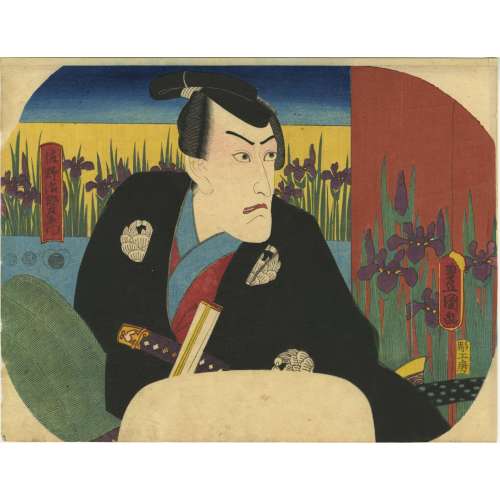 Artist: Utagawa Kunisada [歌川 国貞]; a.k.a. Utagawa Toyokuni III [三代歌川豊国] (Japanese, 1786 – 1865). Signed: Toyokuni ga [豊国 画] in a red toshidama cartouche. Publisher: Ibaya Senzaburō [伊場屋仙三郎] (Japanese, fl. C. 1845 – 1847), seal: San [三] (Marks 11-001 | 127c). Block carver: Matsushima Fusajirō [松嶋房次郎] (Japanese, fl. 1843 – 1850); seal [彫工房] – Hori kō Fusa. Double nanushi censor seal: Kunigasa & Watanabe (1849-50). Actor: Ichikawa Danjūrō VII [市川団十郎] (Japanese, 1791 – 1859); other names: Ichikawa Ebizō V [市川海老蔵], Ichikawa Hakuen II, Ichikawa Shinnosuke I. Play: Yukari no Hana Iro mo Yoshiwara [紫花色吉原], performed at the Kawarazaki Theater (Edo) from the 5th day of the 5th lunar month of Kaei 3 (1850) (see Kabuki Playbill at MFA (Boston) № 11.27996).
Artist: Utagawa Kunisada [歌川 国貞]; a.k.a. Utagawa Toyokuni III [三代歌川豊国] (Japanese, 1786 – 1865). Signed: Toyokuni ga [豊国 画] in a red toshidama cartouche. Publisher: Ibaya Senzaburō [伊場屋仙三郎] (Japanese, fl. C. 1845 – 1847), seal: San [三] (Marks 11-001 | 127c). Block carver: Matsushima Fusajirō [松嶋房次郎] (Japanese, fl. 1843 – 1850); seal [彫工房] – Hori kō Fusa. Double nanushi censor seal: Kunigasa & Watanabe (1849-50). Actor: Ichikawa Danjūrō VII [市川団十郎] (Japanese, 1791 – 1859); other names: Ichikawa Ebizō V [市川海老蔵], Ichikawa Hakuen II, Ichikawa Shinnosuke I. Play: Yukari no Hana Iro mo Yoshiwara [紫花色吉原], performed at the Kawarazaki Theater (Edo) from the 5th day of the 5th lunar month of Kaei 3 (1850) (see Kabuki Playbill at MFA (Boston) № 11.27996).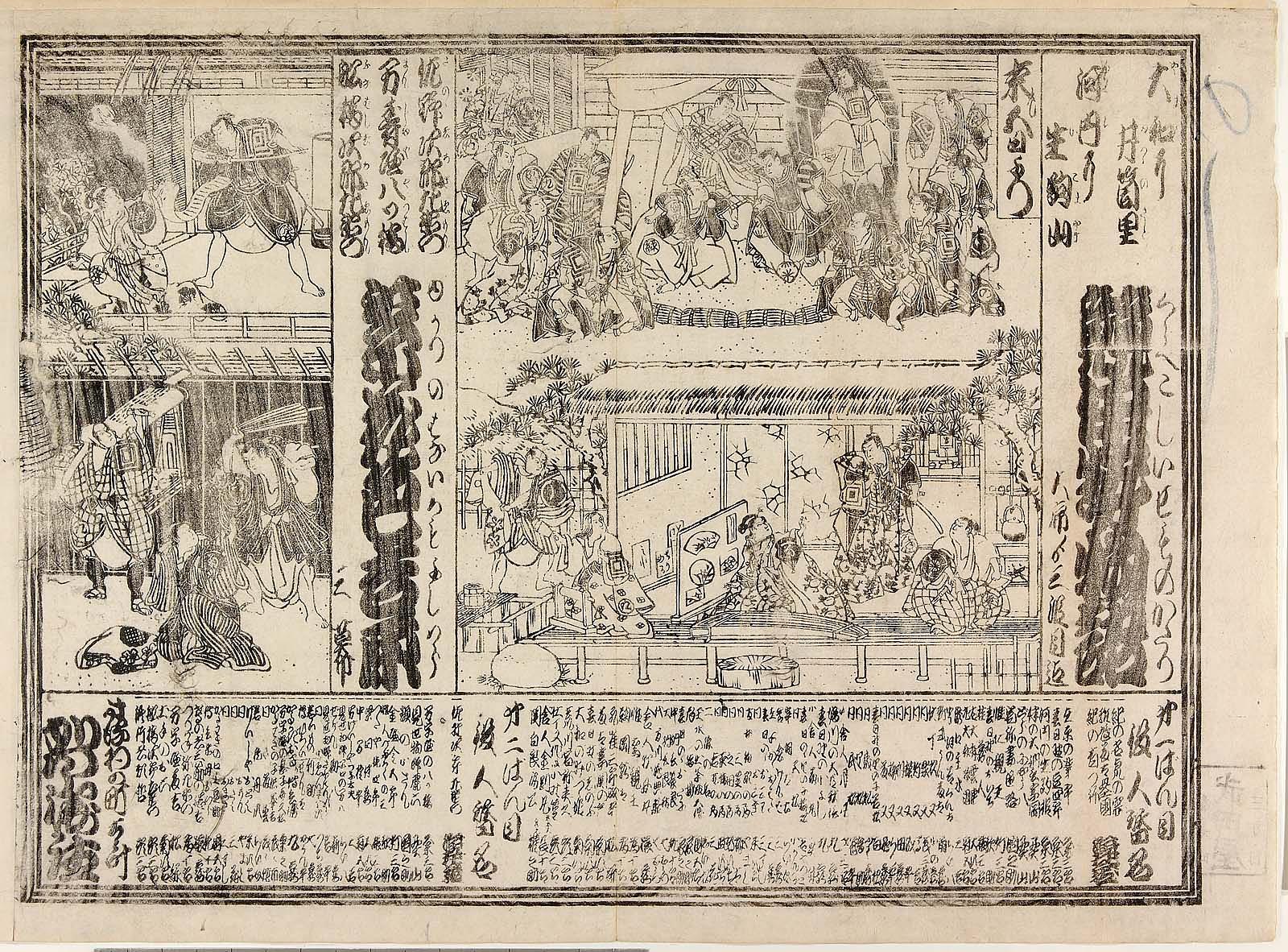 Sano Jirōzaemon [佐野次郎左衛門] – provincial commoner who killed a famous Yoshiwara courtesan named ManjiyaYatsuhashi [万字屋 八ツ橋] (on the second sheet of the pair):
Sano Jirōzaemon [佐野次郎左衛門] – provincial commoner who killed a famous Yoshiwara courtesan named ManjiyaYatsuhashi [万字屋 八ツ橋] (on the second sheet of the pair):
Another Kunisada's print with the same characters in the same play and same performance can be seen at MFA (Boston) № 11.40190.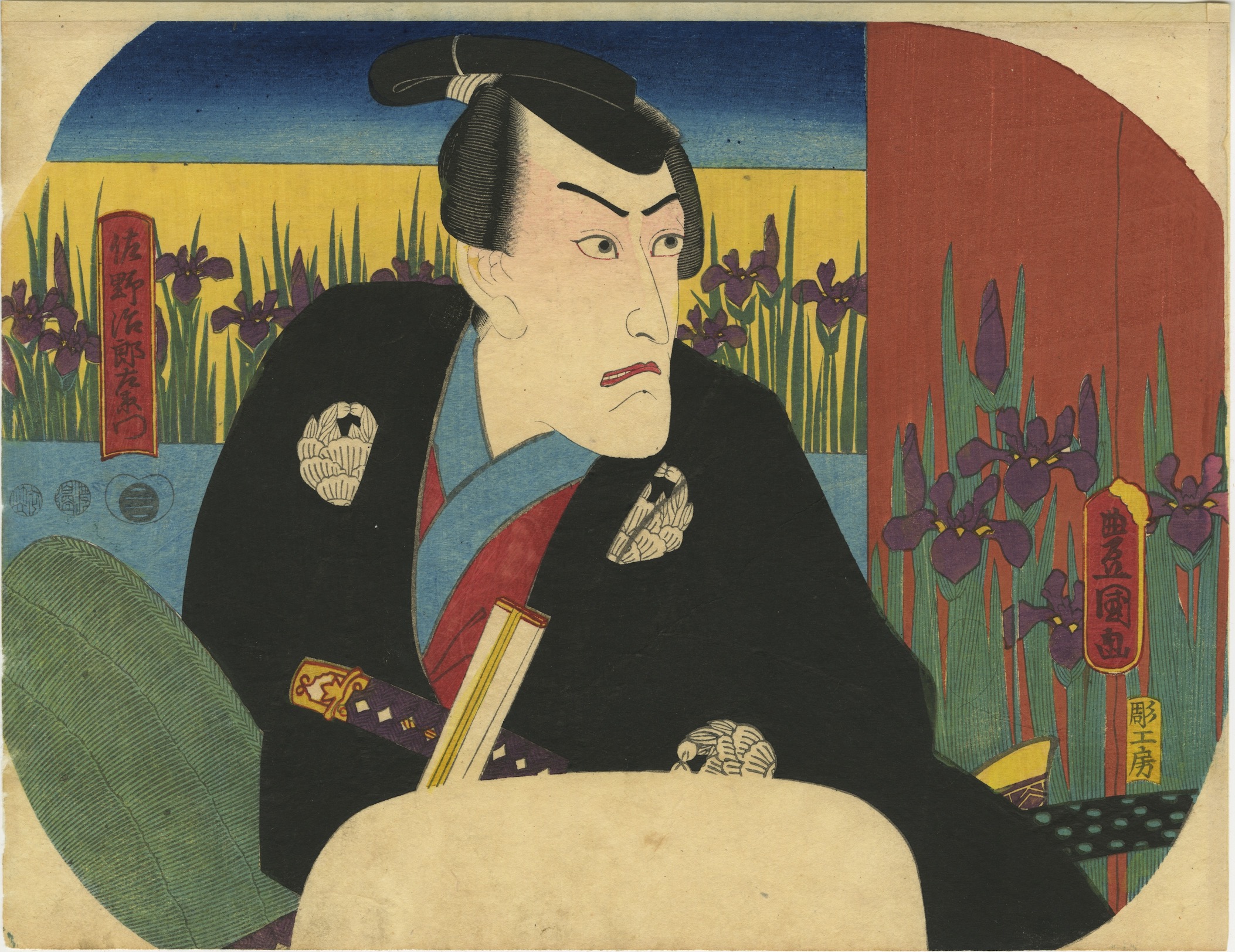
SVJP-0298.2019: Ichikawa Ebizō V as Sano Jirōzaemon.
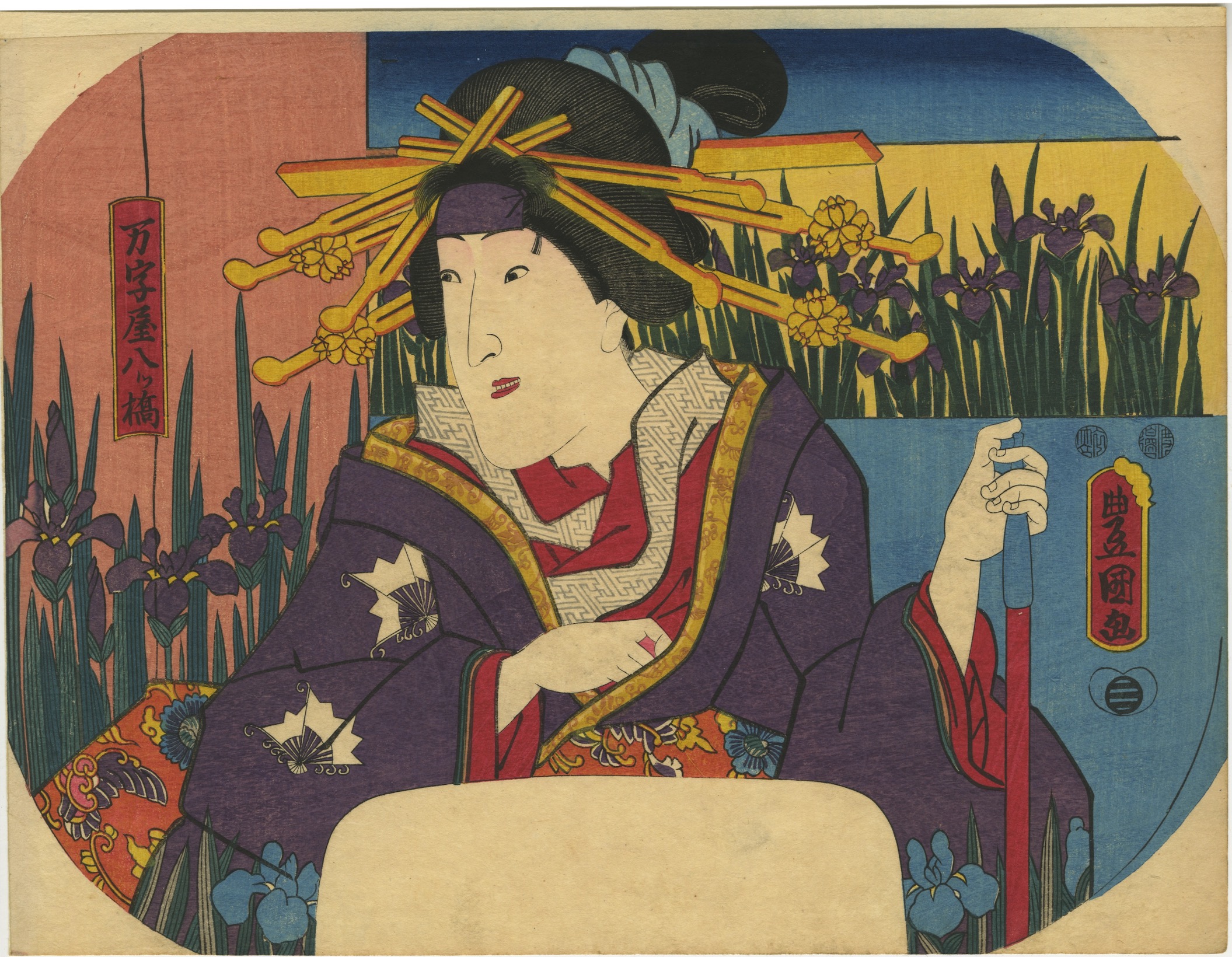
SVJP-0297.2019: Iwai Kumesaburō III as Manjiya Yatsuhashi
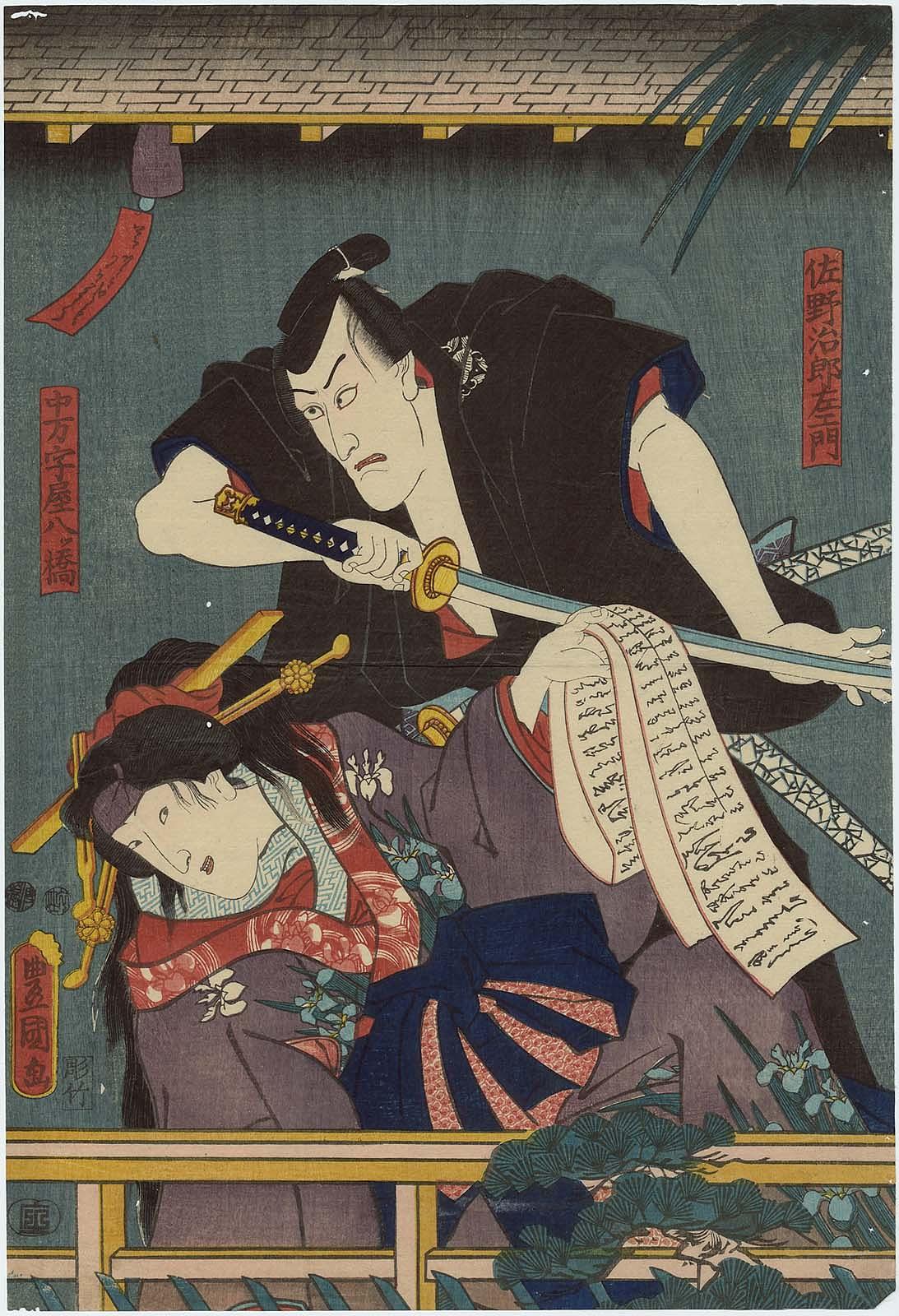 One more example can be seen at the two upper images in Waseda University Cultural Resources Database, № 006-2707:
One more example can be seen at the two upper images in Waseda University Cultural Resources Database, № 006-2707:
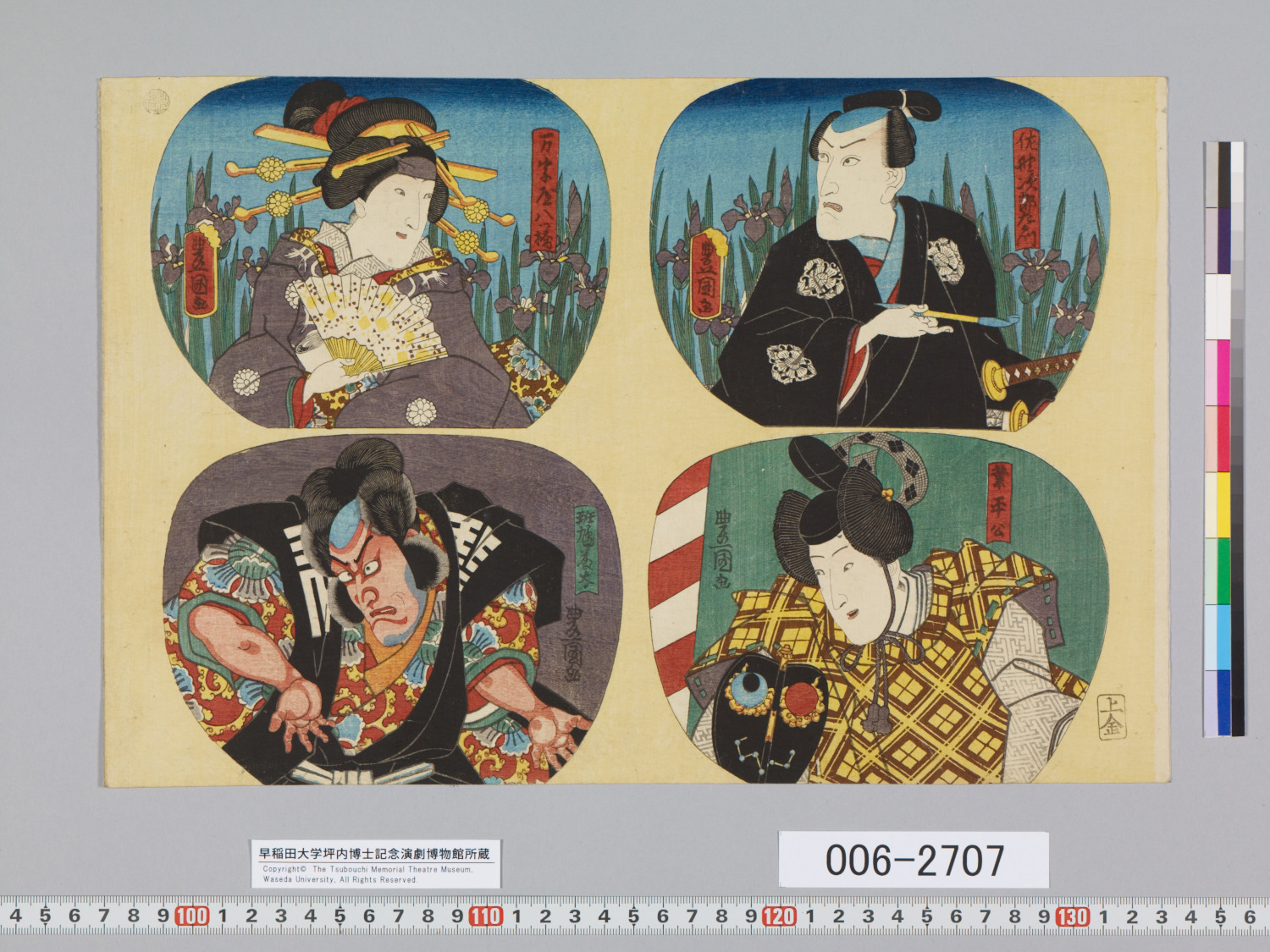
-
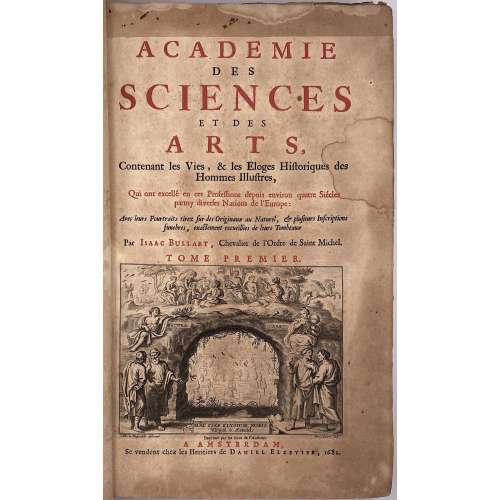 Title: ACADEMIE | DES | SCIENCES | ET DES | ARTS, | Contenant les Vies & les Eloges Historiques des | Hommes Illustres, | Qui ont excellé en ces Professions depuis environ quatre Siécles | parmy diverses Nations de l’Europe : |Avec leurs Pourtraits tirez sur des Originaux au Naturel, & plusieurs Inscriptions | funebres, exactement recueïlies de leurs Tombeaux | Par Isaac Bullart , Chevalier de l’Ordre de Saint Michel. | TOME PREMIER | {allegorical vignette, signed Abr. A Diepenbeke delineavit – Pet. Clouwet sculp.} | Imprimé par les soins de l’Autheur. | A AMSTERDAM, | Se vendent chez les Heritiers de Daniel Elzevier, 1682. || Pagination : [2] – h.t. / blank ; [2] – 1st vol. t.p. in black and red with vignette engraved by Pet. Clouwet after Abr. Diepenbeke / blank; [7] – dedication to Jacques Theodore de Brias {Jacques-Théodore de Bryas (Dutch, 1630 – 1694)}, [9] – preface, [2] – table demonstrative / stanza by Guilielmus Riverius, [2] vinette “Tardius sed grandius” with an elephant in ornamental frame / text; [2] – Advis au lecteur; [1, 2] – f.t. livre premiere, illustres politiques / blank; [2] – noms politiques / blank (A1, after f.t.), 3(A2)-421, [422-424] – table eloges. Collation: [*]6, **8, A6 B-Ggg4. (14 prelim. leaves, as in LIB-2675.2021; the LIB-2676.2021 copy has 12) Binding: 34.5 x 22 x 4.3 cm.34.5 x 22 x 4.3 cm, hardbound; full calf, raised bands. The title is drawn by Abraham van Diepenbeeck (Dutch, 1596 - 1675) and engraved by Peeter Clouwet (Flemish, 1629–1670). The first volume of a two-volume set contains 119 copperplate burin-engraved portraits of selected politicians, historians, jurists, writers, and Italian artists. 26 portraits engraved by Esme de Boulonois (French,1645 – 1681), 3 unsigned, and the rest engraved by Nicolas de Larmessin I (French, 1632 – 1694)Lavinia Vecellio, (Italian, 1530 – 1575), Titian' daughter, engraved by Lamerssin after Titian, Portrait of Jacques Auguste de Thou engraved by de Boulonois after Daniel Dumonstier. Politicians: Antoine Perrenot, Cardinal de Granvelle; Arnaud d'Ossat, Cardinal; Auger Busbeque; Bessarion, Cardinal; François Ximenes, Cardinal; George d'Amboise, Cardinal; Gille Albornoz, Cardinal; Guillaume de Croy; Guy du Faur de Pybrac; Jacques Auguste de Thou; Jean de Selve; Jean Zamoski; Jean de Barnevelt; Jean Armand du Plessis, Cardinal de Richelieu; Jule Mazarin, Cardinal; Michel de l'Hospital; Renaud Pole, Cardinal; Stanislas Hosius, Cardinal; Thomas Morus; Thomas Wolsey, Cardinal. Historians: Bertrand d'Argentré; Cæsar Baronius, Cardinal; Emanuel de Meteren; Enguerand de Monstrelet; Florimond de Remond; François Guicciardin; Fulve Ursin; Guillaume Camden; Henry Catherine d'Avila; Hubert Goltzius; Jacques Amiot; Jean Aventin; Jean Baptiste Platina; Jean Barclay; Jean Froissard; Jean Papirius Masson; Nicolas le Febure; Olivier de la Marche; Onuphre Panuinius; Pandolphe Collenuce; Paul Jove; Philippe de Commines; Pontus Heuterus; Regino Abbé de Prumy; Robert Gaguin; Wolfgang Lazius. Jurists: Alexandre de Tartagnis; André Alciat; André Tiraqueau; Antoine Augustin; Antoine le Febvre; Boece Epo; Charles du Moulin; François Bauduin; Gabriel Mudée; Jacques Cuias; Jason Mainus; Jean Wamese; Mathieu Wesenbec; Philippe Dece; Pierre Peckius; Pierre Pithou; Tibere Decian; Viglius de Zuichem. Writers/Linguists: Ange Politian; Demetrius Chalcondyles; Emanuel Chrysoloras; François Philelphe; François Raphelenge; Guillaume Postel; Jean Argyropilus; Jean Bocace; Jean Lascaris; Jean Passerat; Jean Pierius Valerianus; Jeanne Gray; Nicolas Clenard; Pierre Nannius; Rudolphe Agricola; Theodore Gaza. Italian painters, architects, and sculptors: André Mantegna; André Organa; André del Sarto; André Tafi; André Verrochio; Antoine de Correge; Antoine de Messine; Arnoud di Lappo; Baccio Bandinel; Balthazar Perusi; Bramante d'Urbin; Daniel Ricciarelli; Dominique Beccafumi; Donato; François Mazzuoli; François Primatici; Frere Philippe Lippi; Giorgion; Giotto; Jacques Barozzi de Vignole; Jean Antoine Licinio de Pordenone; Jean Cimabue; Jean d'Udine; Jean François Rustici; Jule Romain; Le Rosso; Leonard de Vinci; Masaccio; Michel-Ange Buonarotti; Perin del Vaga; Philippe Bruneleschi; Philippe Lippi; Polidore de Caravage; Propertia de Rossi; Raphael Sanzio d'Urbin; Sandro Boticelli; Simon Memmi; Taddée Gaddi; Titian Uccello.
Title: ACADEMIE | DES | SCIENCES | ET DES | ARTS, | Contenant les Vies & les Eloges Historiques des | Hommes Illustres, | Qui ont excellé en ces Professions depuis environ quatre Siécles | parmy diverses Nations de l’Europe : |Avec leurs Pourtraits tirez sur des Originaux au Naturel, & plusieurs Inscriptions | funebres, exactement recueïlies de leurs Tombeaux | Par Isaac Bullart , Chevalier de l’Ordre de Saint Michel. | TOME PREMIER | {allegorical vignette, signed Abr. A Diepenbeke delineavit – Pet. Clouwet sculp.} | Imprimé par les soins de l’Autheur. | A AMSTERDAM, | Se vendent chez les Heritiers de Daniel Elzevier, 1682. || Pagination : [2] – h.t. / blank ; [2] – 1st vol. t.p. in black and red with vignette engraved by Pet. Clouwet after Abr. Diepenbeke / blank; [7] – dedication to Jacques Theodore de Brias {Jacques-Théodore de Bryas (Dutch, 1630 – 1694)}, [9] – preface, [2] – table demonstrative / stanza by Guilielmus Riverius, [2] vinette “Tardius sed grandius” with an elephant in ornamental frame / text; [2] – Advis au lecteur; [1, 2] – f.t. livre premiere, illustres politiques / blank; [2] – noms politiques / blank (A1, after f.t.), 3(A2)-421, [422-424] – table eloges. Collation: [*]6, **8, A6 B-Ggg4. (14 prelim. leaves, as in LIB-2675.2021; the LIB-2676.2021 copy has 12) Binding: 34.5 x 22 x 4.3 cm.34.5 x 22 x 4.3 cm, hardbound; full calf, raised bands. The title is drawn by Abraham van Diepenbeeck (Dutch, 1596 - 1675) and engraved by Peeter Clouwet (Flemish, 1629–1670). The first volume of a two-volume set contains 119 copperplate burin-engraved portraits of selected politicians, historians, jurists, writers, and Italian artists. 26 portraits engraved by Esme de Boulonois (French,1645 – 1681), 3 unsigned, and the rest engraved by Nicolas de Larmessin I (French, 1632 – 1694)Lavinia Vecellio, (Italian, 1530 – 1575), Titian' daughter, engraved by Lamerssin after Titian, Portrait of Jacques Auguste de Thou engraved by de Boulonois after Daniel Dumonstier. Politicians: Antoine Perrenot, Cardinal de Granvelle; Arnaud d'Ossat, Cardinal; Auger Busbeque; Bessarion, Cardinal; François Ximenes, Cardinal; George d'Amboise, Cardinal; Gille Albornoz, Cardinal; Guillaume de Croy; Guy du Faur de Pybrac; Jacques Auguste de Thou; Jean de Selve; Jean Zamoski; Jean de Barnevelt; Jean Armand du Plessis, Cardinal de Richelieu; Jule Mazarin, Cardinal; Michel de l'Hospital; Renaud Pole, Cardinal; Stanislas Hosius, Cardinal; Thomas Morus; Thomas Wolsey, Cardinal. Historians: Bertrand d'Argentré; Cæsar Baronius, Cardinal; Emanuel de Meteren; Enguerand de Monstrelet; Florimond de Remond; François Guicciardin; Fulve Ursin; Guillaume Camden; Henry Catherine d'Avila; Hubert Goltzius; Jacques Amiot; Jean Aventin; Jean Baptiste Platina; Jean Barclay; Jean Froissard; Jean Papirius Masson; Nicolas le Febure; Olivier de la Marche; Onuphre Panuinius; Pandolphe Collenuce; Paul Jove; Philippe de Commines; Pontus Heuterus; Regino Abbé de Prumy; Robert Gaguin; Wolfgang Lazius. Jurists: Alexandre de Tartagnis; André Alciat; André Tiraqueau; Antoine Augustin; Antoine le Febvre; Boece Epo; Charles du Moulin; François Bauduin; Gabriel Mudée; Jacques Cuias; Jason Mainus; Jean Wamese; Mathieu Wesenbec; Philippe Dece; Pierre Peckius; Pierre Pithou; Tibere Decian; Viglius de Zuichem. Writers/Linguists: Ange Politian; Demetrius Chalcondyles; Emanuel Chrysoloras; François Philelphe; François Raphelenge; Guillaume Postel; Jean Argyropilus; Jean Bocace; Jean Lascaris; Jean Passerat; Jean Pierius Valerianus; Jeanne Gray; Nicolas Clenard; Pierre Nannius; Rudolphe Agricola; Theodore Gaza. Italian painters, architects, and sculptors: André Mantegna; André Organa; André del Sarto; André Tafi; André Verrochio; Antoine de Correge; Antoine de Messine; Arnoud di Lappo; Baccio Bandinel; Balthazar Perusi; Bramante d'Urbin; Daniel Ricciarelli; Dominique Beccafumi; Donato; François Mazzuoli; François Primatici; Frere Philippe Lippi; Giorgion; Giotto; Jacques Barozzi de Vignole; Jean Antoine Licinio de Pordenone; Jean Cimabue; Jean d'Udine; Jean François Rustici; Jule Romain; Le Rosso; Leonard de Vinci; Masaccio; Michel-Ange Buonarotti; Perin del Vaga; Philippe Bruneleschi; Philippe Lippi; Polidore de Caravage; Propertia de Rossi; Raphael Sanzio d'Urbin; Sandro Boticelli; Simon Memmi; Taddée Gaddi; Titian Uccello. -
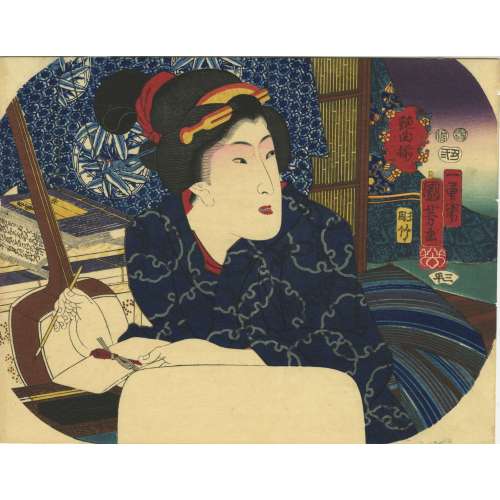 Artist: Utagawa Kuniyoshi [歌川 國芳] (Japanese, 1798 – 1861) Publisher: British Museum provides for the title as Enkyoku-zoroi [艶曲揃] (Set of Voluptuous Melodies) and the publisher as Sanpei. Indeed, 三平 (Sanpei) was a wholesale fan shop at the end of the Edo period. However, Andreas Marks identifies the publisher's seal as 三平 Mihei = Mikawaya Heiroku (1848-56), a member of the Fan Producing Guild (AM 11-016|325a). Block carver: Yokokawa Takejirō, seal: Carver Taki [彫竹] (Hori Take)
Artist: Utagawa Kuniyoshi [歌川 國芳] (Japanese, 1798 – 1861) Publisher: British Museum provides for the title as Enkyoku-zoroi [艶曲揃] (Set of Voluptuous Melodies) and the publisher as Sanpei. Indeed, 三平 (Sanpei) was a wholesale fan shop at the end of the Edo period. However, Andreas Marks identifies the publisher's seal as 三平 Mihei = Mikawaya Heiroku (1848-56), a member of the Fan Producing Guild (AM 11-016|325a). Block carver: Yokokawa Takejirō, seal: Carver Taki [彫竹] (Hori Take)Signed: Ichiyosai Kuniyoshi ga in a red cartouche and sealed with paulownia (kiri mon).
Date seal and double nanushi censor seals: Fuku & Muramatsu, 1853 (Kaei 6, 2nd month).
Size: Uchiwa-e (untrimmed fan print) 296 x 230 mm.
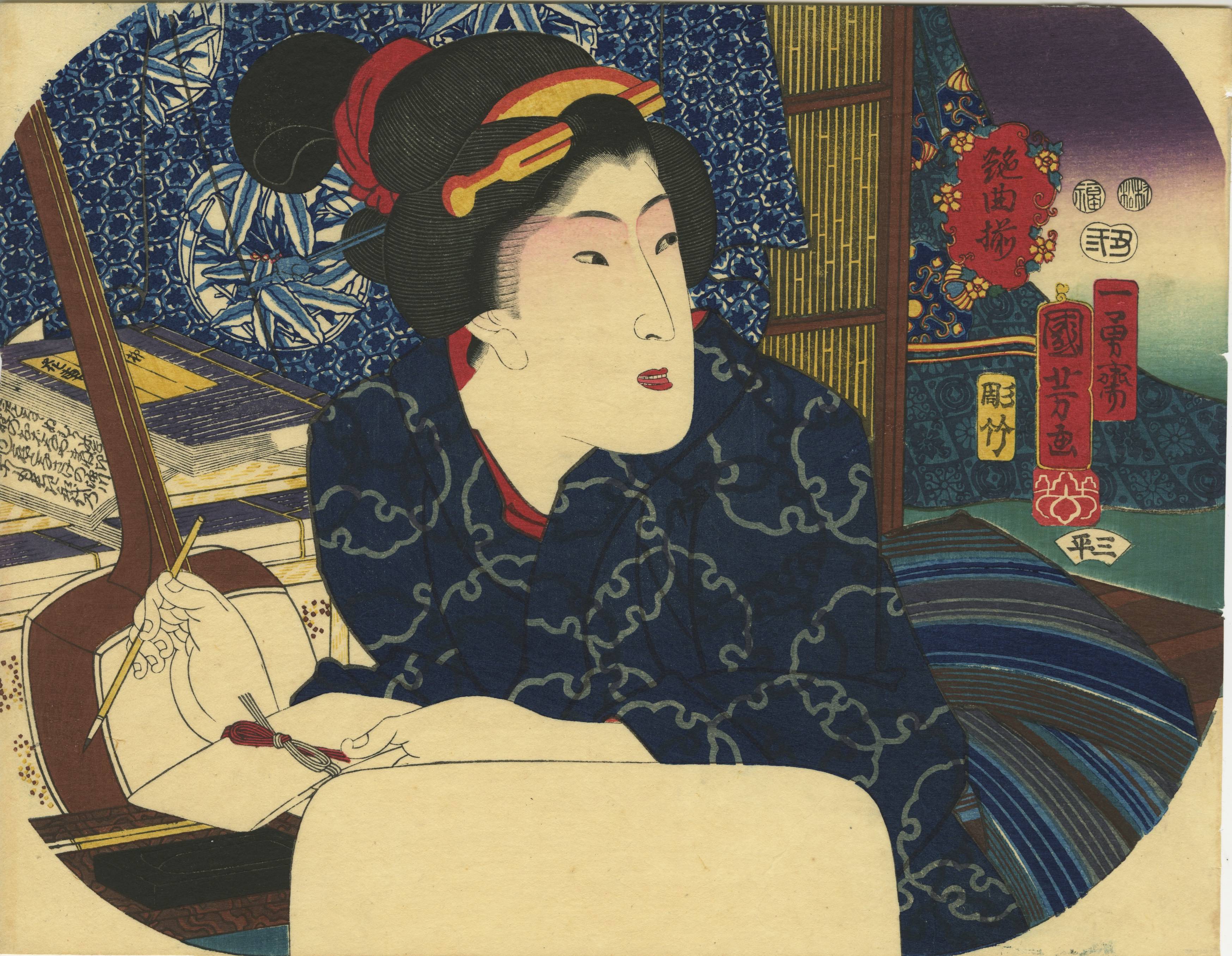
SVJP-0303.2019
-
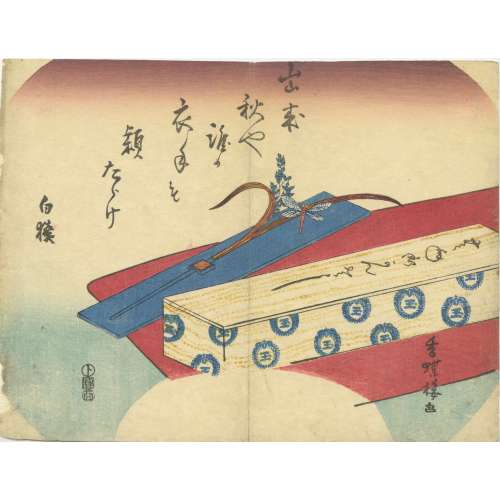 Utagawa Kunisada [歌川 国貞] a.k.a. Utagawa Toyokuni III [三代歌川豊国] (Japanese, 1786 – 1865)
Utagawa Kunisada [歌川 国貞] a.k.a. Utagawa Toyokuni III [三代歌川豊国] (Japanese, 1786 – 1865)Promotional fan for a hairpin shop, with a poem by Ichikawa Danjuro VII, signed Hakuen.
Date seal plus rectangular kiwame seal: Bunsei 8 (1825).
Size: Fan print. Uchiwa-e (27.5 x 21.1 cm) Publisher seal: Maru-To (2) (Marks U204). Date seal plus rectangular kiwame seal: Bunsei 8 (1825). -
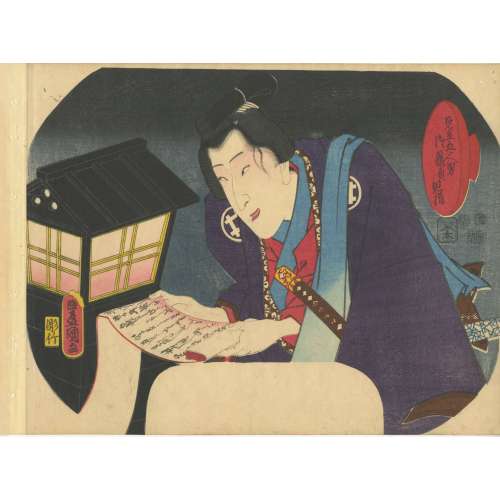 Utagawa Kunisada [歌川 国貞] a.k.a. Utagawa Toyokuni III [三代歌川豊国] (Japanese, 1786 – 1865).
Utagawa Kunisada [歌川 国貞] a.k.a. Utagawa Toyokuni III [三代歌川豊国] (Japanese, 1786 – 1865).Uncut fan print (uchiwa-e), 295 x 230 mm, depicting kabuki actor Bandō Shūka I as Shirai Gonpachi (白井権八) reading a scroll by the light of a lantern. From the series A Parody of the Five Chivalrous Commoners; a Cup of Sake From Their Fans (Mitate gonin otoko, go-hiiki no omoizashi). According to Paul Griffith, the term omoizashi refers to the act of pouring a cup of sake for one's chosen partner, here giving an impression of intimacy and affection between famous actors and their patrons.
Actor: Bandō Shūka I [初代坂東しうか] (Japanese, 1813-1855); other names: Bandō Tamasaburō I, Bandō Mitsugorō V (posthumously). The print was probably published by some unknown Yama-Ta (Marks U421b). Double nanushi censor seals and date seal: Muramatsu and Fuku, Kaei 5, 2nd month (2/1852). As Kabuki Encyclopedia put it: "Gonpachi. A parasite. From the character named Shirai Gonpachi who lives at the home of Banzui Chōbei and sponges off him" (An English-Langauge Adaptation of Kabuki Jiten. Samuel L. Leiter. Greenwood Press, 1979, pp. 26, 98-9). There were many kabuki plays based on the story of the lovers Miura-ya Komurasaki and Shirai Gonpachi. (See: [LIB-2226.2019] Algernon Bertram Freeman-Mitford. Tales of Old Japan. — London: Macmillan and Co., 1883). Ref.: Art shop Ezoshi Ukiyoe new collection news, vol. 66, 2023.1 (Jan) # 31, p.8. -
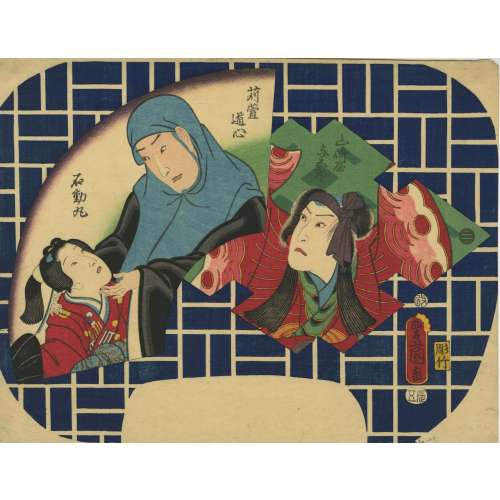 Utagawa Kunisada [歌川 国貞]; a.k.a. Utagawa Toyokuni III [三代歌川豊国] (Japanese, 1786 – 1865). Signed: Toyokuni ga [豊国 画] in a red toshidama cartouche. Publisher: Ibaya Senzaburō [伊場屋仙三郎] (Japanese, fl. 1815 – 1869). Block carver: Yokokawa Takejirō [横川竹二郎] (Japanese, fl. 1845 – 1863), seal: 彫竹 – Hori Take. Date seal and aratame censor seal: May of the Year of Dragon [辰五] (Tatsu-go) (5/1856) (Not in Marks).
Utagawa Kunisada [歌川 国貞]; a.k.a. Utagawa Toyokuni III [三代歌川豊国] (Japanese, 1786 – 1865). Signed: Toyokuni ga [豊国 画] in a red toshidama cartouche. Publisher: Ibaya Senzaburō [伊場屋仙三郎] (Japanese, fl. 1815 – 1869). Block carver: Yokokawa Takejirō [横川竹二郎] (Japanese, fl. 1845 – 1863), seal: 彫竹 – Hori Take. Date seal and aratame censor seal: May of the Year of Dragon [辰五] (Tatsu-go) (5/1856) (Not in Marks).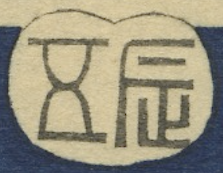 Uncut fan print (uchiwa-e) depicting Onoe Kikugorō IV as Karukaya Dōshin parting from his son, Ishidomaru (played by Ichimura Uzaemon XIII), and Kawarasaki Gonjūrō I as Yamazakiya Yogoro in the kabuki play Karukaya Dōshin Tsukushi no Iezuto [苅萱桑門筑紫𨏍], written by Namiki Sōsuke [並木宗輔] (Japanese, 1695 – 1751) and performed at Ichimuraza [市村座] in 05/1856.
Media: Fan print [団扇絵] (Uchiwa-e); size: 235 x 305 mm.
Actors:
Onoe Kikugorō IV [四代目 尾上菊五郎] (Japanese, 1808 – 1860); other names: Onoe Baikō IV, Onoe Eizaburō III, Onoe Kikue, Nakamura Tatsuzō, Nakamura Kachō.
Onoe Kikugorō V [五代目尾上菊五郎] (Japanese, 1844 – 1903 other names: Onoe Baikō V, Ichimura Kakitsu IV, Ichimura Uzaemon XIII [十三代目市村羽左衛門], Ichimura Kurōemon.
Ichikawa Danjūrō IX [市川団十郎] (Japanese, 1838 – 1903); other names: Kawarasaki Sanshō, Kawarasaki Gonnosuke VII, Kawarasaki Gonjūrō I, Kawarasaki Chōjūrō III.
Plot: It was a popular belief at one time that jealous women had their hair transformed into writhing serpents and Kato Sayemon Shige-Uji, a daimyo of Tsukushi, a much-married man, suffered from the delusion that his wife was so affected. He fled to the mountains to escape her and led the life of a hermit under the name of Karukaya Doshin [苅萓道心]. One day, on Mount Kōya (高野山, Kōyasan) Karukaya meets a young man who was wandering in the mountains. Being questioned, the youth tells his name, Ishidomaru, and elicits the information that he is seeking his lost father. Karukaya then recognizes the boy as his own son, but firm in the resolve to remain lost to the world, he refrains from disclosing himself, and bids the youth return home.
Provenance: Paul F. Walter (American, 1935 – 2017).
Ref.:
Uncut fan print (uchiwa-e) depicting Onoe Kikugorō IV as Karukaya Dōshin parting from his son, Ishidomaru (played by Ichimura Uzaemon XIII), and Kawarasaki Gonjūrō I as Yamazakiya Yogoro in the kabuki play Karukaya Dōshin Tsukushi no Iezuto [苅萱桑門筑紫𨏍], written by Namiki Sōsuke [並木宗輔] (Japanese, 1695 – 1751) and performed at Ichimuraza [市村座] in 05/1856.
Media: Fan print [団扇絵] (Uchiwa-e); size: 235 x 305 mm.
Actors:
Onoe Kikugorō IV [四代目 尾上菊五郎] (Japanese, 1808 – 1860); other names: Onoe Baikō IV, Onoe Eizaburō III, Onoe Kikue, Nakamura Tatsuzō, Nakamura Kachō.
Onoe Kikugorō V [五代目尾上菊五郎] (Japanese, 1844 – 1903 other names: Onoe Baikō V, Ichimura Kakitsu IV, Ichimura Uzaemon XIII [十三代目市村羽左衛門], Ichimura Kurōemon.
Ichikawa Danjūrō IX [市川団十郎] (Japanese, 1838 – 1903); other names: Kawarasaki Sanshō, Kawarasaki Gonnosuke VII, Kawarasaki Gonjūrō I, Kawarasaki Chōjūrō III.
Plot: It was a popular belief at one time that jealous women had their hair transformed into writhing serpents and Kato Sayemon Shige-Uji, a daimyo of Tsukushi, a much-married man, suffered from the delusion that his wife was so affected. He fled to the mountains to escape her and led the life of a hermit under the name of Karukaya Doshin [苅萓道心]. One day, on Mount Kōya (高野山, Kōyasan) Karukaya meets a young man who was wandering in the mountains. Being questioned, the youth tells his name, Ishidomaru, and elicits the information that he is seeking his lost father. Karukaya then recognizes the boy as his own son, but firm in the resolve to remain lost to the world, he refrains from disclosing himself, and bids the youth return home.
Provenance: Paul F. Walter (American, 1935 – 2017).
Ref.:
- [LIB-2110.2019] Samuel L. Leiter. Historical Dictionary of Japanese Traditional Theatre (Historical Dictionaries of Literature and the Arts). / 2nd edition. – Lanham: Rowman & Littlefield, 2014; pp. 379-380.
- [LIB-2206.2019] Basil Stewart. Subjects portrayed in Japanese colour-prints. — London: Kegan Paul, Trench, Trubner & Co. Ltd., 1922.
-
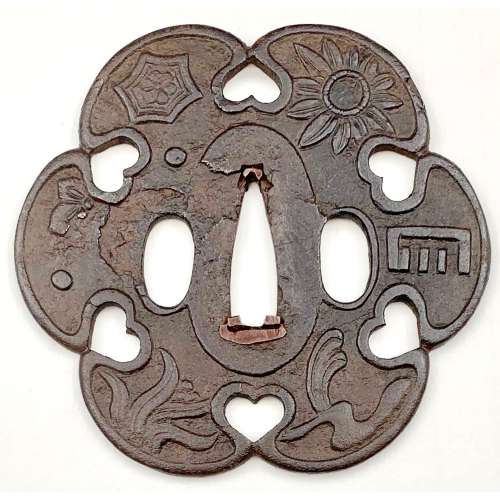 Iron tsuba of six-lobed (mutsu-mokkō-gata) form, with six wild boar's eye shape (inome) openings (sukashi). Ryo-Hitsu and the entire perimeter of tsuba have typical for this school raised rim; raised seppa dai. Lobes are decorated in low relief carving (sukidashi-bori). On the obverse: chrysanthemum, Genji mon, waves and rocks, grasses and star, bellflower, star and flower in tortoiseshell (kikko). On the reverse: Stars and different flowers, and flying geese. The plate is damaged to the left of nakago-ana and around the left hitsu-ana. Kamakura-bori school. Late Muromachi period (1514-1573). Diameter: 89 mm; Thickness at seppa-dai: 4.0 mm; Weight: 108.8 g [large]. There is a similar tsuba in this collection, TSU-0345.2018, but with a different motif and much smaller: diameter 74.3 mm, thickness at seppa-dai: 3.2 mm, weight: 62.8 g.Another look-a-like tsuba can be found at the Compton Collection, part II, pp. 14-15, №17, though his tsuba is more massive (80 x 84 x 4 mm).
Iron tsuba of six-lobed (mutsu-mokkō-gata) form, with six wild boar's eye shape (inome) openings (sukashi). Ryo-Hitsu and the entire perimeter of tsuba have typical for this school raised rim; raised seppa dai. Lobes are decorated in low relief carving (sukidashi-bori). On the obverse: chrysanthemum, Genji mon, waves and rocks, grasses and star, bellflower, star and flower in tortoiseshell (kikko). On the reverse: Stars and different flowers, and flying geese. The plate is damaged to the left of nakago-ana and around the left hitsu-ana. Kamakura-bori school. Late Muromachi period (1514-1573). Diameter: 89 mm; Thickness at seppa-dai: 4.0 mm; Weight: 108.8 g [large]. There is a similar tsuba in this collection, TSU-0345.2018, but with a different motif and much smaller: diameter 74.3 mm, thickness at seppa-dai: 3.2 mm, weight: 62.8 g.Another look-a-like tsuba can be found at the Compton Collection, part II, pp. 14-15, №17, though his tsuba is more massive (80 x 84 x 4 mm).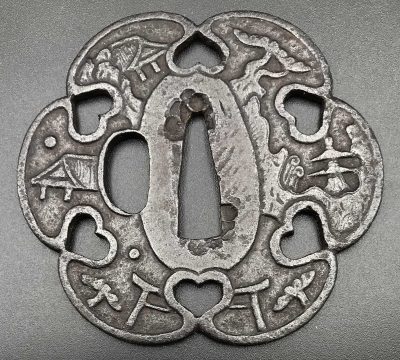
Varshavsky Collection: TSU-0345.2018
This tsuba, TSU-0401.2019, is the biggest of all three (another mine and the one from Campton Collection). The presence of a flower in a tortoiseshell symbol (crest or mon) on this tsuba alludes to Izumo Shrine. The overall piece, with symbols of grasses, waves, flowers, incense, stars, and flying geese, is full of autumnal connotations.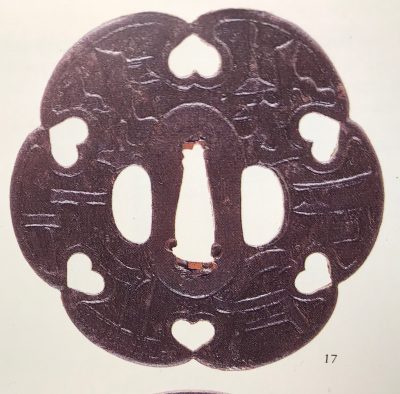
Compton Collection, part II, pp. 14-15, №17: Kamakura-bori tsuba, ca. 1450.
-
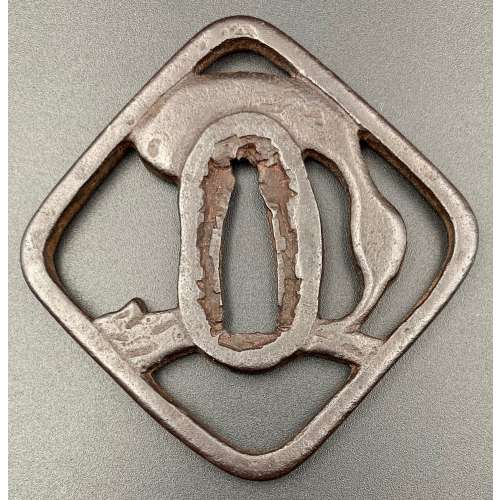
Iron tsuba of diamond form with rounded corners with the design of a double gourd on a branch in openwork. Dark brown patina. Ko-Shōami school. Custom kiri-wood box with hakogaki of Sasano Masayuki.
Momoyama Period (1574-1603)
Size: 77.1 x 75.7 x 4.6 mm; weight: 75.3 g.
Provenance: Sasano Masayuki[Translated by Markus Sesko]Hakogaki lid outside: 古正阿弥鐔 Ko-Shōami tsuba Hakogaki lid inside:Hyōtan-sukashi Mumei, Momoyama-ki saku Tetsu, ji-sukashi Koboku-aware no kasaku Heisei ninen Soshinkan Minazuki Openwork design of gourd Unsigned, Momoyama era work Iron, large openwork Masterwork full of classical charm. June of 1990, Soshinkan [pen name of Sasano Masayuki]瓢簞透 無銘 桃山期作 鉄地透
古撲惻之佳作 平成二年 素心鑑 水無月
-
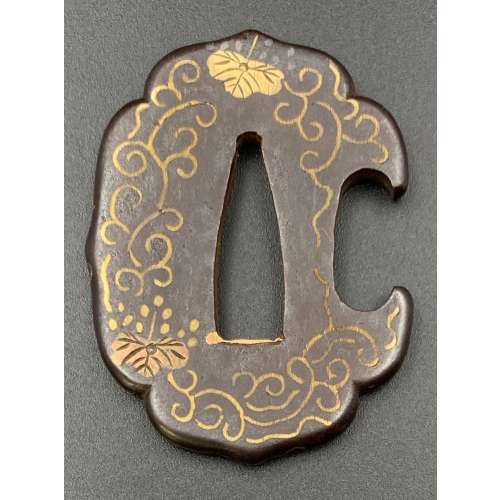
Small iron tsuba (tantō size) of aoi form with the design of paulownia leaves and blossoms in copper and brass flat inlay (hira-zōgan). Brass sekigane. Open kozuka hitsu-ana.
Early Edo period, 17th century.
Size: 53.4 x 40.7 x 4.4 mm; weight: 47.4 g
-
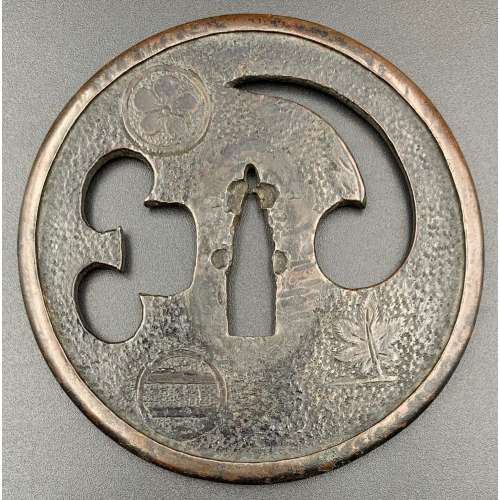
Yamagane (bronze) tsuba (kagamishi, or mirror-maker) with the design of tomoe (comma) and suhama in openwork. Surface treated with hammer marks and chiselled with the design of maple leaves and encircled two bars (maru-ni-futatsu-biki, Ashikaga clan family crest, or mon) on both sides. Raised rim or rim cover (fukurin). Custom kiri-wood box.
Size: 87.4 x 86.2 x 2.9 (center), 4.9 (rim) mm; weight: 120 g. -
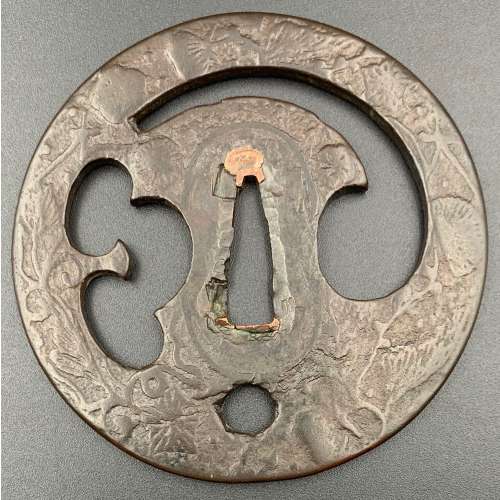
Yamagane (bronze) tsuba (kagami-shi, or mirror-maker) with the design of a star (round opening), tomoe (comma), and suhama in openwork. Surface cast and chiselled with the design of foliage, vines, blossoms, pine needles, and fruits on both sides.
The end of Early Muromachi period (1393-1453), circa 1450. Size: 83.7 x 84.1 x 3.6 (center), 4.1 (rim) mm; weight: 135.5 g. KANTEI-SHO (鑑定書) - APPRAISAL [translated by Markus Sesko]. No 463341 Tomoe-suhama-sukashi hana-karakusa no zu tsuba (巴洲浜透花唐草図鐔) ‒ Tsuba with stylized comma and bay inlet openwork and a flower and arabesque décor Unsigned: Kagami-shi (鏡師) Round shape, yamagane, hammer blow finish, cast, negative openwork design, round rim. According to the result of the shinsa committee of our society, we judge this work as authentic and rank it as Hozon Tōsōgu. July 1, 2011 [Foundation] Nihon Bijutsu Tōken Hozon Kyōkai, NBTHK (日本美術刀劍保存協會) -
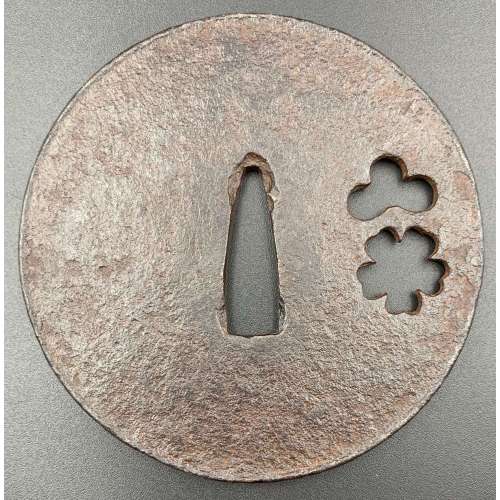
Iron tsuba with hammer marked surface and design of a plum and cherry blossoms to the right of nakaga-ana in openwork (sukashi). Raised rim, typical to katchushi school. The thickness of the plate provides for later Muromachi period making.
Late Muromachi period (1514-1573). Size: 85.8 x 85.0 x 3.6 (center), 4.1 (rim) mm; weight: 136 g. -
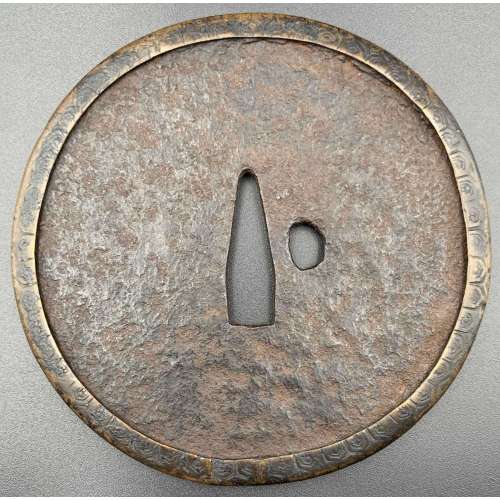
Large iron tsuba with hammer marks on the surface, small oval opening to the right of nakaga-ana; yamagane fukurin chiselled with tortois shell diaper pattern.
Early Muromachi period (1393-1453). Size: 101.2 x 101.9 x 2.4 (center), 5.2 (rim) mm; weight: 148.4 g. -
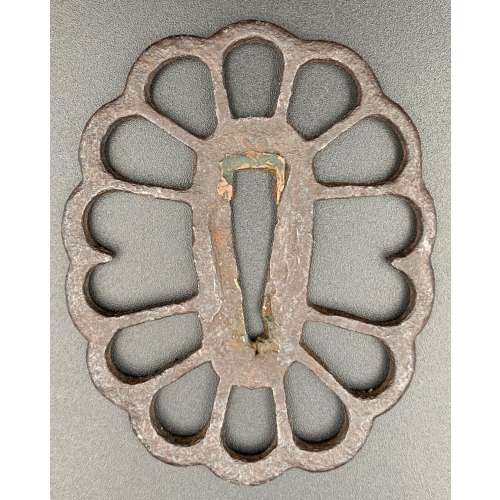
Iron tsuba with chrysanthemum design in openwork (sukashi). Copper sekigane.
Late Heian through Kamakura period (ca. 1150 - 1200's).
Size: 78.4 x 60.9 x 3.5 mm; weight: 45.7 g
Provenance: Boris Markhasin Message from Boris Markhasin (13-AUG-2019): It is a very rudimentary tachi tsuba, and the iron is old and really nothing to draw attention. However, this is a very old tsuba, and that is what makes it very special and an important study piece. This tsuba likely dates to the late Heian through Kamakura (ca. 1150 - 1200's) -- by consensus, since such examples are extremely rare, and none are mounted to my knowledge, so few direct analogues. The form is interesting for a variety of reasons. The smaller size, an oval form is associated more with 12th/13th c styles. The sukashi kiku motif is very interesting as it clearly pushes back the dating of large scale sukashi far back in time. This shouldn't be surprising, but for some reason, we (really mainly westerners) naively tend to associate sukashi with the Muromachi and younger. The two missing spokes are by consensus likely later removals to accommodate kozuka and kogai -- but this is not certain, and it could be an original styling. A key kantei point is the elongate, narrow, slightly squared seppa dai. This is a characteristic of early koshirae, which were much thinner and more delicate than the types we are used to seeing that date pretty much to the late Muromachi and later. I am always amazed when I have a chance to interrogate early koshirae at how thin they are - I want to call them fragile, but they were actually quite resilient. The walls were super thin, but the top and bottom edges were a bit thicker, providing a bit of structural support... but this is another thread topic. Of all the tsuba I have owned, this is the tsuba that has most clearly reflected the shape of the old style of saya / tsuka. -
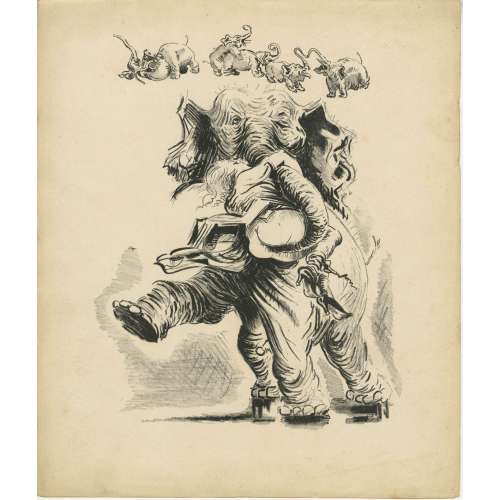
Album of 20 hand-coloured lithographs with a title page and a 'justification du tirage' page in an original snakeskin-clothed cardboard binder. Drawn on stone by Anonymous, attributed to Santippa. The theme of these pictures can be described as erotic humour.
Edition: 200 copies printed in Bruxelles, c. 1938; this copy without a number.
Watermarked wove paper: Word "Marais" and a flower.
Dimensions: 24.3 x 29.3 cm According to J.-P. Dutel, the author of these images is Georges Hoffmann under the pseudonym Santippa. Honesterotica provides a different name: Gaston Hoffmann [Santippa] (French, 1883 – 1977), which seems adequate. Catalogue raisonné: Dutel (1920-70) № 2496. -
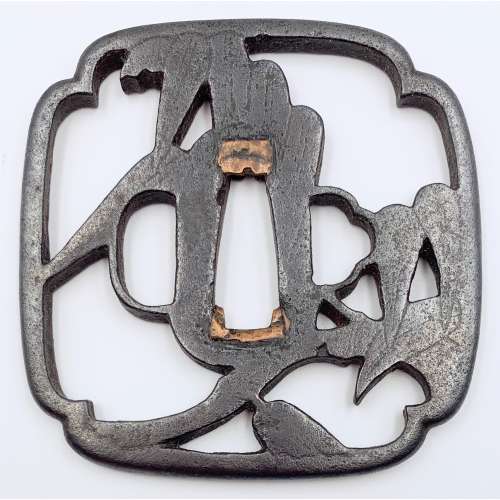 Iron tsuba of quatrefoil form with design of bamboo stems and leaves in openwork (sukashi) decorated with carving (kebori) . Copper sekigane. Early Edo period, late 17th century (Kanbun / Enppo era). First generation Kanshiro of Nishigaki school in Higo Province died in the sixth year of Genroku, 1693, at the age of 81). Height: 74.4 mm; Width: 74.2 mm; Centre thickness: 4.9 mm. Rounded rim. The design was quite popular among the Higo masters.
Iron tsuba of quatrefoil form with design of bamboo stems and leaves in openwork (sukashi) decorated with carving (kebori) . Copper sekigane. Early Edo period, late 17th century (Kanbun / Enppo era). First generation Kanshiro of Nishigaki school in Higo Province died in the sixth year of Genroku, 1693, at the age of 81). Height: 74.4 mm; Width: 74.2 mm; Centre thickness: 4.9 mm. Rounded rim. The design was quite popular among the Higo masters.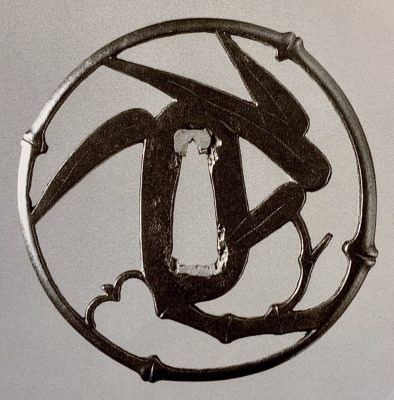
Kanshiro III, early 18th century (Sasano 1994 №267)
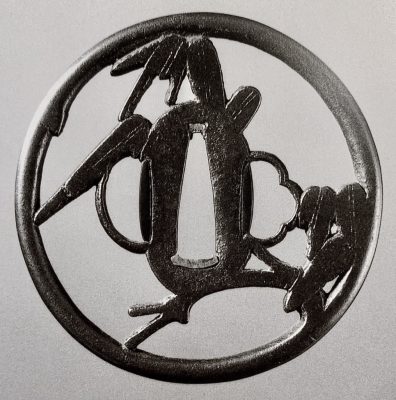
Matashichi I, late 17th century (Sasano 1994 №270)
The design of my tsuba closely resembles the one at the last example (Sasano 1994 №280), however, the form (mine is quatrefoil) and the execution (strength) are very different, which result in a very different spirit of my piece.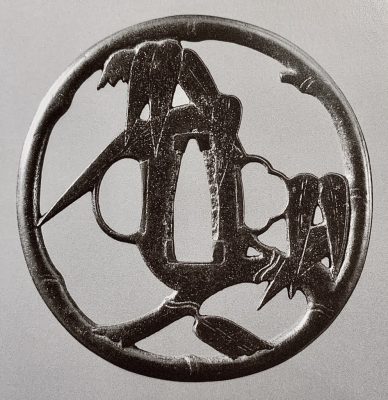
Shigemitsu II, early 18th century (Sasano 1994 №280)



